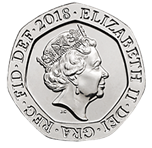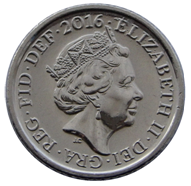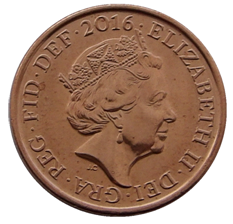
The British decimal twenty pence (20p) coin – often pronounced "twenty pee" – is a unit of currency equal to 20/100 of a pound sterling. Like the 50p coin, it is an equilateral curve heptagon. Its obverse has featured the profile of Queen Elizabeth II since the coin's introduction on 9 June 1982. Four different portraits of the Queen have been used; the latest design by Jody Clark was introduced in 2015. The second and current reverse, featuring a segment of the Royal Shield, was introduced in 2008.

The British decimal five pence (5p) coin – often pronounced five pee – is a unit of currency equaling five one-hundredths of a pound sterling. Its obverse has featured the profile of Queen Elizabeth II since the coin’s introduction on 23 April 1968, replacing the shilling in preparation for decimalisation in 1971. A smaller version of the coin was introduced in June 1990 with the older coins being withdrawn on 31 December 1990. Four different portraits of the Queen have been used, with the latest design by Jody Clark being introduced in 2015. The second and current reverse, featuring a segment of the Royal Shield, was introduced in 2008.

The British decimal one penny (1p) coin, usually simply known as a penny, is a unit of currency equalling one one-hundredth of a pound sterling. The penny’s symbol is p. Its obverse has featured the profile of Queen Elizabeth II since the coin’s introduction on 15 February 1971, the day British currency was decimalised. Four different portraits of the Queen have been used on the coin, with the latest design by Jody Clark being introduced in 2015. The second and current reverse, featuring a segment of the Royal Shield, was introduced in 2008.

The lira was the currency of Italy between 1861 and 2002 and of the Albanian Kingdom between 1941 and 1943. Between 1999 and 2002, the Italian lira was officially a national subunit of the euro. However, cash payments could be made in lira only, as euro coins or notes were not yet available. The lira was also the currency of the Napoleonic Kingdom of Italy between 1807 and 1814.
The New Guinean pound was the currency of the Australian Territory of New Guinea between 1915 and 1966, and replaced the New Guinean mark when Australia occupied the former German colony at the end of World War I. The New Guinean pound was subdivided into 20 shillings, each of 12 pence, and was equal to the Australian pound. The Australian currency circulated alongside coins issued specifically for New Guinea between 1929 and 1945. New Guinea coins ceased to be produced in 1945, and production of Papua New Guinea resumed in the 1970s.
Christopher Ironside FSIA 1970, OBE 1971, FRBS 1977 was an English painter and coin designer, particularly known for the reverse sides of the new British coins issued on decimalisation in 1971.
The One guilder coin was a coin struck in the Kingdom of the Netherlands between 1818 and 2001. It remained in circulation until 2002 when the guilder currency was replaced by the euro. No guilder coins were minted in the German occupation of the Netherlands in World War II.

The twenty-five øre coin was a coin of the Danish krone. It was the lowest-denomination coin in the country when it was demonetised on 1 October 2008.
The half-cent coin was a Dutch coin used from 1818 to 1940. It was the smallest-denomination coin of the decimal Dutch guilder until its withdrawal from circulation after the German occupation of the Netherlands in 1940. It was nicknamed "Halfje", similar to the Kwartje.

The krone coin is the second-smallest denomination of the Danish krone.

The twenty-five cent was a coin worth a quarter of decimal Dutch guilder. It was used from the decimalisation of the currency in 1817 until the Netherlands adopted the euro as sole currency in 2002. The last minting was in 2001. The coin was the third-smallest denomination of the guilder when the currency was withdrawn, and the largest of a value less than one guilder.

The 2 øre coin was made during the German occupation of Denmark between 1941 and 1945, and then by the Danish government in 1947. It was first minted in aluminum, and then from 1942 to 1947 in zinc. The aluminum 2 øre is identical to the zinc variety, although the latter is a little heavier in weight.

The Five cent coin was a coin struck in the Kingdom of the Netherlands between 1818 and 2001. Twenty stuivers equalled a Dutch Guilder.
The Two and a half cent coin was struck in the Kingdom of the Netherlands between 1818 and 1942. All coins were minted in Utrecht.

The one-cent coin was a coin struck in the Kingdom of the Netherlands between 1817 and 1980. The coin was worth 1 cent or 1⁄100 of a Dutch guilder.
The Three guilder coin was a silver coin struck in the Kingdom of the Netherlands between 1817 and 1832.

The Indian 10-rupee coin is a denomination of the Indian rupee. The ₹10 coin is the highest-denomination coin minted in India since its introduction in 2005. The present ₹10 coin in circulation is from the 2011 design. However, the previous ₹10 coins minted before 2011 are also legal tender in India. All ₹10 coins containing with and without the rupee currency sign are legal tender, as stated by the Reserve Bank of India. Along with the standard designs, there are 21 different designs for this denomination and are minted as circulating commemorative coins, this is used alongside the 10 rupee banknote.

The One rupee coin is an Indian coin worth one Indian rupee and is made up of a hundred paisas. Currently, one rupee coin is the smallest Indian coin in circulation. Since 1992, one Indian rupee coins are minted from stainless steel. Round in shape, the one rupee coins weighs 3.76 grams, has a diameter of 21.93-millimetre (0.863 in) and thickness of 1.45-millimetre (0.057 in). In independent India, one rupee coins was first minted in 1950 and is currently in circulation.

The Philippine two peso coin (₱2) was a denomination of Philippine currency. It was minted by the Bangko Sentral ng Pilipinas from 1983 until 2000 when it was demonetized.

The Philippine fifty centavo coin (50¢) was a denomination of Philippine currency. It was minted from 1880 until 2000 when it was demonetized.















